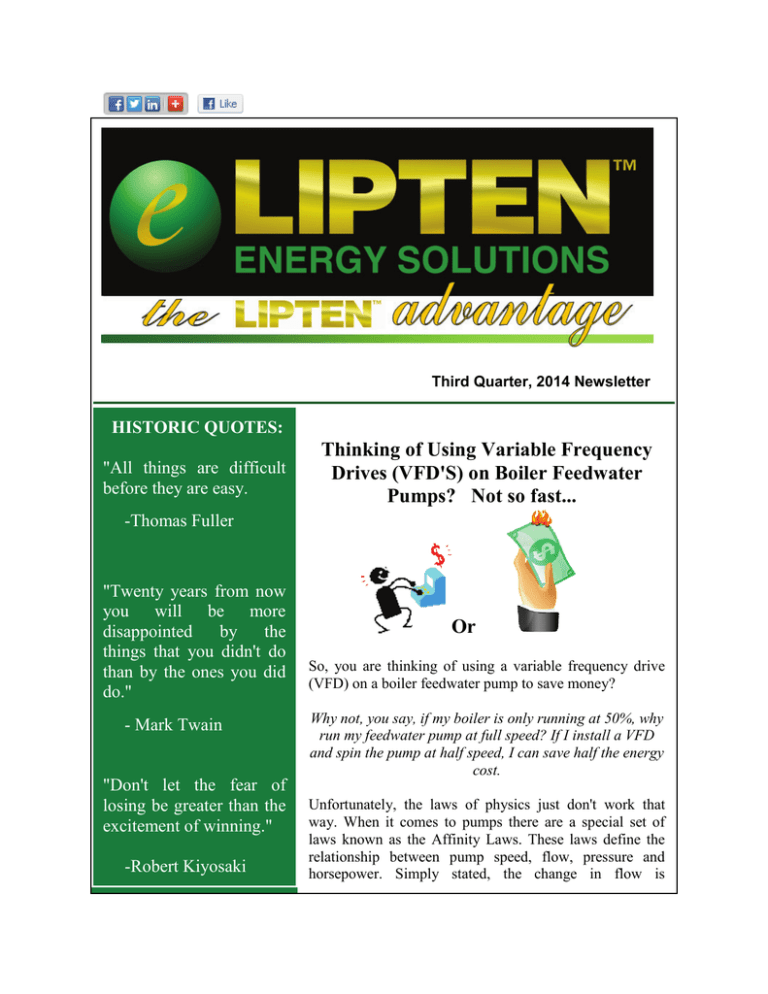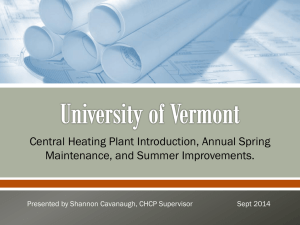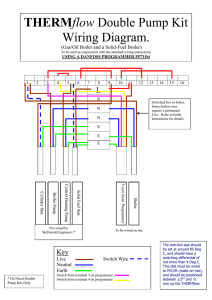
Third Quarter, 2014 Newsletter
HISTORIC QUOTES:
"All things are difficult
before they are easy.
Thinking of Using Variable Frequency
Drives (VFD'S) on Boiler Feedwater
Pumps? Not so fast...
-Thomas Fuller
"Twenty years from now
you will be more
disappointed
by
the
things that you didn't do
than by the ones you did
do."
- Mark Twain
"Don't let the fear of
losing be greater than the
excitement of winning."
-Robert Kiyosaki
Or
So, you are thinking of using a variable frequency drive
(VFD) on a boiler feedwater pump to save money?
Why not, you say, if my boiler is only running at 50%, why
run my feedwater pump at full speed? If I install a VFD
and spin the pump at half speed, I can save half the energy
cost.
Unfortunately, the laws of physics just don't work that
way. When it comes to pumps there are a special set of
laws known as the Affinity Laws. These laws define the
relationship between pump speed, flow, pressure and
horsepower. Simply stated, the change in flow is
proportional to the change in speed, the change in pressure
(head) is proportional to the change in speed squared, and
the change in horsepower is proportional to the change in
speed cubed. Expressed as equations these are:
- Google "boiler coal to
gas conversion company"
Lipten is Number 1!
- Lipten was awarded a
contract for a boiler coal
to natural gas conversion
of third 210,000 lb/hr
boiler after successful
conversion a customer's
other two similar boilers.
- Lipten was awarded a
contract for conversion of
two 150,000 lb/hr coal
boilers to natural gas
firing.
- Lipten and our partner
were awarded a contract
for
the
design-build
installation
of
two
120,000 lbs/hr boilers.
RPM1/RPM2 = FLOW1/FLOW2
(RPM1/RPM2)^2 = HEAD1/HEAD2
(RPM1/RPM2)^3 = HP1/HP2
So, how does this apply to a VFD on your feedwater
pump? Let's see what happens when we apply the affinity
laws to your pump running at 50%...
Speed:
True, if your 3600 RPM pump is now running at 1800
RPM, the ratio would be 1800/3600 = 0.5, and the flow
would be cut in half, just what you want. But wait! No
water is getting into your boiler! What's going on?
Pressure:
It's the second affinity law that got you! At 50% speed, the
pressure is reduced by (0.5)^2 or down to 25%. Boiler
feedwater pumps are sized to run at ASME code
requirements, meaning that you furnish feedwater to your
boiler at least 3% higher pressure than the relief valve
setting on the boiler (plus pressure drops between the
pump and the boiler). So, say your boiler operating at 120
PSI has a maximum working pressure of 150PSI. That
means your feedwater pump was probably designed to
operate at around 160 PSI. At 50% speed, the pump is
only putting out 40 PSI, certainly not enough to overcome
the 160 psi at the boiler! Working the equations backwards
to maintain at least 150 PSI, the slowest the pump can spin
is √150/160 x 3600 = 3486 RPM or just a 3% speed
decrease!
Horsepower and $Cost$:
Energy usage = horsepower. So can you really save on
your energy costs? With just a 3% speed reduction, the
motor horsepower decreases (3486/3600)^3 which is 9%
less horsepower. On a 10HP motor, that's 1HP or .745KW.
Using a rate of $0.07 /KWH, a 24/7/365 operation would
save no more than $450 a year. So, if the cost of installing
a VFD was only $5,000, you've got a payback greater than
10 years. Even if you have a larger boiler with a 100HP
feedwater pump, you are saving ~$4,500 a year with a
VFD. Assuming a very conservative $25,000 cost for the
VFD installation means a payback greater than 5 years.
But what if...?
What if a boiler ran at 600 psi and is being reconfigured to
run at 150 psi? The feedwater pumps would be oversized
for the new operating conditions. Therefore, the pumps
may be able to reduce speed significantly without
dropping under the required pressure. This could be a
significant cost savings. Also, what if your electrical rates
are double those used in the examples? Your savings
would double.
So, is using a VFD on a boiler feedwater pump a good
idea? Maybe. Just make sure you are using the right
figures in your evaluation and don't break any (affinity)
laws!
DILBERT © (2010) Scott Adams. Used by permission of UNIVERSAL UCLICK. All rights reserved.
Did you know ...
Radiant Heat vs Convective Heat
Radiant heat is transferred through space to a surface by electromagnetic
radiation (think infrared light). This is exactly how the sun warms the earth.
Convective heat requires a fluid that can flow, like a liquid or a gas. Heat
energy is transferred by the contact of the fluid with a surface.
In the case of a boiler, water is heated by both forms of heat. In the combustion
area, the heat released from burning fuel (coal, gas, oil, etc.) radiates energy
from the flame to the walls of the boiler tubes (radiant heat). Beyond the
combustion area, the flow of the hot flue gas passes over boiler tubes
transferring additional heat (convective heat).
Lipten Race Car Update
The second stop of the season for the #21 Lipten Energy Solutions Acura
RSX was the Historic Road Atlanta in Braselton, Georgia for the 37th annual
HSR MITTY. During this two day event, driver Eric Filgueiras dominated his
class, finishing 2nd on Saturday and 1st on Sunday. With a class of 10 cars
and an overall field of 54 cars on the track, Filgueiras quickly found his
footing with both car and circuit, proving his ability as a driver who can
compete among some of the best.
The 20 year-old pilot saw crowded racing conditions Saturday afternoon for
race 1 with substantial traffic to work through. With the races being 7 lap
features, each driver had to make their moves quickly, with Eric doing so,
battling to end the first race 2nd in class and 16th overall. On Sunday
afternoon everything went Filgueiras' way, as he made quick work of the class
leader and overall position, ending the race 1st in class and 11th overall! It was
a great weekend all around for the up-and-coming driver. "I couldn't be more
pleased with how this weekend went for us," explained Filgueiras, "I wasn't
sure what to expect with this being my second weekend in this car and never
having driven at Road Atlanta. I love the course and the event that James
Redman and everyone at HSR puts on is absolutely top notch. I especially
want to thank Lipten Energy Solutions, Kovi Consulting, and everyone who
continues to get behind my efforts week in and week out."
Lipten is Hiring!
Lipten is looking for experienced power plant mechanical engineers, project
managers, software developers and service technicians.
If you're interested in a dynamic career with a healthy, growing firm, you've
come to the right place. Lipten Company offers competitive salaries and a
comprehensive benefits package including medical, dental and 401(k) as well
as three weeks paid personal time off in addition to ten paid holidays. Lipten is
an equal opportunity employer
Click here to see if you are interested in potentially being part of the Lipten
winning team.
Lipten Mission Statement
Lipten will make "power" a source of value for our clients by providing
superior engineering, procurement and construction of steam, hot water,
compressed air, chilled water and electrical systems. Lipten operates
profitably throughout the world in an ethical, environmentally sensitive and
socially responsible manner while focusing on the core principals of systems'
safety, reliability and efficiency. Essential to achieving our goals is our
dedication to maintaining a positive working environment.
Please Click Here to view newsletters and more on
the LIPTEN website.
Lipten is an Engineering, Procurement and Construction (EPC) firm that specializes in
Central Energy Plant (CEP) design and construction. Lipten also has a controls group that
provides standard and custom control solutions.
Lipten provides steam generation, power generation, chilled water systems, compressed air
systems, water treatment systems, controls and related Energy Center equipment and
services. Lipten's level of support can vary from an advisory role to complete turn-key
facility construction. Services include: design, engineering, drafting (CAD), equipment
specifications, procurement, installation, construction management, site audits, start-up,
operator training and maintenance.






